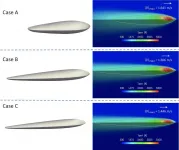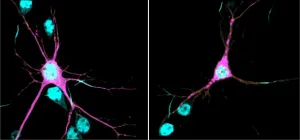(Press-News.org) Additive manufacturing has the potential to allow one to create parts or products on demand in manufacturing, automotive engineering, and even in outer space. However, it's a challenge to know in advance how a 3D printed object will perform, now and in the future.
Physical experiments -- especially for metal additive manufacturing (AM) -- are slow and costly. Even modeling these systems computationally is expensive and time-consuming.
"The problem is multi-phase and involves gas, liquids, solids, and phase transitions between them," said University of Illinois Ph.D. student Qiming Zhu. "Additive manufacturing also has a wide range of spatial and temporal scales. This has led to large gaps between the physics that happens on the small scale and the real product."
Zhu, Zeliang Liu (a software engineer at Apple), and Jinhui Yan (professor of Civil and Environmental Engineering at the University of Illinois), are trying to address these challenges using machine learning. They are using deep learning and neural networks to predict the outcomes of complex processes involved in additive manufacturing.
"We want to establish the relationship between processing, structure, properties, and performance," Zhu said.
Current neural network models need large amounts of data for training. But in the additive manufacturing field, obtaining high-fidelity data is difficult, according to Zhu. To reduce the need for data, Zhu and Yan are pursuing 'physics informed neural networking,' or PINN.
"By incorporating conservation laws, expressed as partial differential equations, we can reduce the amount of data we need for training and advance the capability of our current models," he said.
Using the Frontera and Stampede2 supercomputers at the Texas Advanced Computing Center (the #10 and #36 fastest in the world, as of June 2021), Zhu and Yan simulated the dynamics of two benchmark experiments: an example of 1D solidification, when solid and liquid metals interact; and an example of laser beam melting tests taken from the 2018 NIST Additive Manufacturing Benchmark Test Series.
In the 1D solidification case, they input data from experiments into their neural network. In the laser beam melting tests, they used experimental data as well as results from computer simulations. They also developed a 'hard' enforcement method for boundary conditions, which, they say, is equally important in the problem-solving.
The team's neural network model was able to recreate the dynamics of the two experiments. In the case of the NIST Challenge, it predicted the temperature and melt pool length of the experiment within 10% of the actual results. They trained the model on data from 1.2 to 1.5 microseconds and made predictions at further time steps up to 2.0 microseconds.
The team published their results in Computational Mechanics in January 2021.
"This is the first time that neural networks have been applied to metal additive manufacturing process modeling," Zhu said. "We showed that physics-informed machine learning, as a perfect platform to seamlessly incorporate data and physics, has big potential in the additive manufacturing field."
Zhu sees engineers in the future using neural networks as fast prediction tools to provide guidance on the parameter selection for the additive manufacturing process -- for instance, the speed of the laser or the temperature distribution -- and to map the relationships between additive manufacturing process parameters and the properties of the final product, such as its surface roughness.
"If your client requires a specific property, then you'll know what you should use for your manufacturing process parameters," Zhu said.
In a separate paper in Computational Methods in Applied Mechanics and Engineering published online in May 2021, Zhu and Yan proposed a modification of the existing finite element method framework used in additive manufacturing to see if their technique could get better predictions over existing benchmarks.
Mirroring a recent additive manufacturing experiment from Argonne National Lab involving a moving laser, the researchers showed that simulations, performed on Frontera, differed in depth from those in the experiment by less than 10.3% and captured the common experimentally-observed chevron-type shape on the metal top surface.
Zhu and Yan's research benefits from the continued growth of computing technologies and federal investment in high performance computing.
Frontera not only speeds up studies such as theirs, it opens the door to machine and deep learning studies in fields where training data is not widely available, broadening the potential of AI research.
"The most exciting point is when you see that your model can predict the future using only a small amount of existing data," Zhu said. "It's somehow learning about the evolution of the process.
"Previously, I was not very confident on whether we'd be able to predict with good accuracy over temperature, velocity, and geometry of the gas-metal interface. We showed that we're able to make nice data inferences."
INFORMATION:
Early 2020 saw the world break into what has been described as a "war-like situation": a pandemic, caused by the severe acute respiratory syndrome-related coronavirus 2 (SARS-CoV-2), the likes of which majority of the living generations across most of the planet have not ever seen. This pandemic has downed economies and resulted in hundreds of thousands of deaths. At the dawn of 2021, vaccines have been deployed, but before populations can be sufficiently vaccinated, effective treatments remain the need of the hour.
Thus, other than fast-tracking research into novel drugs, scientists have also been exploring their ...
Breeding better crops through genetic engineering has been possible for decades, but the use of genetically modified plants has been limited by technical challenges and popular controversies. A new approach potentially solves both of those problems by modifying the energy-producing parts of plant cells and then removing the DNA editing tool so it cannot be inherited by future seeds. The technique was recently demonstrated through proof-of-concept experiments published in the journal Nature Plants by geneticists at the University of Tokyo.
"Now we've got a way to modify chloroplast genes specifically and measure their potential to make a good plant," said Associate Professor Shin-ichi ...
"We know that children use a lot of different information sources in their social environment, including their own knowledge, to learn new words. But the picture that emerges from the existing research is that children have a bag of tricks that they can use", says Manuel Bohn, a researcher at the Max Planck Institute for Evolutionary Anthropology.
For example, if you show a child an object they already know - say a cup - as well as an object they have never seen before, the child will usually think that a word they never heard before belongs with the new object. Why? Children use information ...
In a rapidly changing Arctic, one area might serve as a refuge - a place that could continue to harbor ice-dependent species when conditions in nearby areas become inhospitable. This region north of Greenland and the islands of the Canadian Arctic Archipelago has been termed the Last Ice Area. But research led by the University of Washington suggests that parts of this area are already showing a decline in summer sea ice.
Last August, sea ice north of Greenland showed its vulnerability to the long-term effects of climate change, according to a study published July 1 in the open-access journal Communications Earth & Environment.
"Current thinking is that this area may be the last refuge for ice-dependent ...
Elephants and their forebears were pushed into wipeout by waves of extreme global environmental change, rather than overhunting by early humans, according to new research.
The study, published today in Nature Ecology & Evolution, challenges claims that early human hunters slaughtered prehistoric elephants, mammoths and mastodonts to extinction over millennia. Instead, its findings indicate the extinction of the last mammoths and mastodonts at the end of the last Ice Age marked the end of progressive climate-driven global decline among elephants over millions of years.
Although elephants today are restricted to just three endangered species in the African and Asian tropics, these are survivors of a once far more diverse and widespread group of giant herbivores, known ...
FINDINGS
Men with high-risk prostate cancer with at least one additional aggressive feature have the best outcomes when treated with multiple healthcare disciplines, known as multimodality care, according to a UCLA study led by Dr. Amar Kishan, assistant professor of radiation oncology at the David Geffen School of Medicine at UCLA and a researcher at the UCLA Jonsson Comprehensive Cancer Center.
The study found no difference in prostate cancer-specific deaths across treatment modalities when patients received guideline-concordant multimodality therapy, which in this case was inclusion of hormone therapy for men receiving radiation ...
A water disinfectant created on the spot using just hydrogen and the air around us is millions of times more effective at killing viruses and bacteria than traditional commercial methods, according to scientists from Cardiff University.
Reporting their findings today in the journal Nature Catalysis, the team say the results could revolutionise water disinfection technologies and present an unprecedented opportunity to provide clean water to communities that need it most.
Their new method works by using a catalyst made from gold and palladium that takes in hydrogen and oxygen to form ...
As many expectant mothers know, getting enough folate is key to avoiding neural tube defects in the baby during pregnancy. But for the individuals who carry certain genetic variants, dealing with folate deficiency can be a life-long struggle which can lead to serious neurological and heart problems and even death.
Now a Donnelly Centre study offers clues to how to recognize early those who are most at risk.
Defects in an enzyme called MTHFR, or 5,10-methylenetetrahydrofolate reductase, which modifies folate, or vitamin B9 as it is also known, to produce ...
CHAPEL HILL, NC - Scientists at the University of North Carolina at Chapel Hill School of Medicine and colleagues have demonstrated that variants in the SPTBN1 gene can alter neuronal architecture, dramatically affecting their function and leading to a rare, newly defined neurodevelopmental syndrome in children.
Damaris Lorenzo, PhD, assistant professor in the UNC Department of Cell Biology and member of the UNC Neuroscience Center at the UNC School of Medicine, led this research, which was published today in the journal Nature Genetics. Lorenzo, who is also a member of the UNC Intellectual and Developmental Disabilities Research Center (IDDRC) at the UNC School of Medicine, is the ...
Hundreds of genetic drivers affect sexual and reproductive behaviour
Combined with social factors, these can affect longevity and health
An Oxford-led team, working with Cambridge and international scholars, has discovered hundreds of genetic markers driving two of life's most momentous milestones - the age at which people first have sex and become parents.
In a paper published today in Nature Human Behaviour, the team linked 371 specific areas of our DNA, called genetic variants (known locations on chromosomes), 11 of which were sex-specific, to the timing of first sex and birth. These variants interact with environmental factors, such as socioeconomic status and when you were born, and are predictors of longevity and later life disease.
The researchers ...





